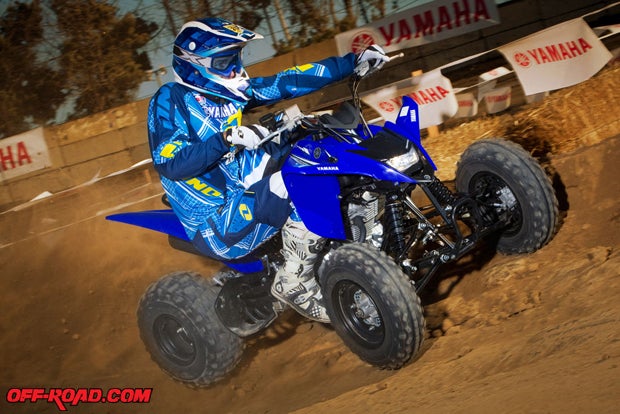
Never ones to shy away from pushing the envelope, Yamaha has come to market with a sporty new Raptor 125 for 2011, the first of its kind from a major ATV manufacturer.
This is not Yamaha’s first foray into lightweight sport quads; when it was introduced in 2008, the Raptor 250 turned the class on its ear. Previously the 250 class featured heavier, less sporty ATVs, but the Raptor 250 was a true-blue sport quad with a lightweight chassis and an impressive 249cc mill. The brand new Raptor 125 delivers these same attributes to a class currently dominated by Chinese and Taiwanese ATVs that are often plagued by poor production quality and nearly non-existent dealer support.
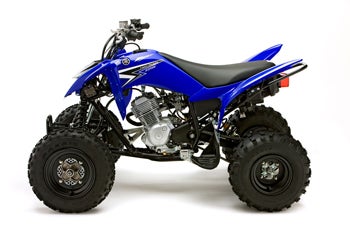 One of Yamaha’s main goals with the new Raptor was to provide a reasonably priced ($3,399), sport-specific ATV for new riders that features Japanese quality and is supported by an immense dealer network. To accomplish this, Yamaha borrowed heavily from its hugely successful Raptor 250.
One of Yamaha’s main goals with the new Raptor was to provide a reasonably priced ($3,399), sport-specific ATV for new riders that features Japanese quality and is supported by an immense dealer network. To accomplish this, Yamaha borrowed heavily from its hugely successful Raptor 250.
The Raptor 125 was designed in part to be a transition model from 90cc youth ATVs to full-sized adult sport quads. Outfitted with a five-speed manual transmission, it’s a good way for a young adult do learn how to operate a clutch. Doing this on a 125cc machine is a much less intimidating process than jumping right onto a high-powered race quad.
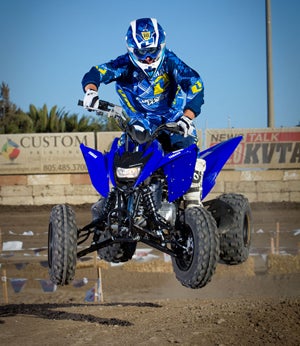 Helping entice new riders, the Raptor 125 looks the part of a sport ATV. Modeled after its big brother, the Raptor 250, it is easy to see the similarities in looks. The Raptor 125 features aggressive plastic lines that are matched by a very stylish single 30-watt headlight that offers great illumination. In addition to the standard Yamaha Team Blue color scheme, a white Raptor 125 is also available with two graphic kits to choose from. Yamaha offers a skull and flames graphics kit as well as pink graphics to meet both boys and girls likings, respectively.
Helping entice new riders, the Raptor 125 looks the part of a sport ATV. Modeled after its big brother, the Raptor 250, it is easy to see the similarities in looks. The Raptor 125 features aggressive plastic lines that are matched by a very stylish single 30-watt headlight that offers great illumination. In addition to the standard Yamaha Team Blue color scheme, a white Raptor 125 is also available with two graphic kits to choose from. Yamaha offers a skull and flames graphics kit as well as pink graphics to meet both boys and girls likings, respectively.
Ever since we got word of the new 2011 Yamaha Raptor 125 we’ve been counting down the days until we got to throw a leg over the new machine. Fortunately, Yamaha answered the call by asking us to come out to the West Coast to put the new Raptor through its paces.
Yamaha arranged a whole day of riding in Ventura, Calif. Nestled right on the beach, Yamaha built a custom track designed specifically for the Raptor 125 at Ventura Raceway – a facility known for hosting a variety of racing events including sprint car and flat track nationals. The track featured long sweeping corners, tight berms, a few table tops, and a whoop section.
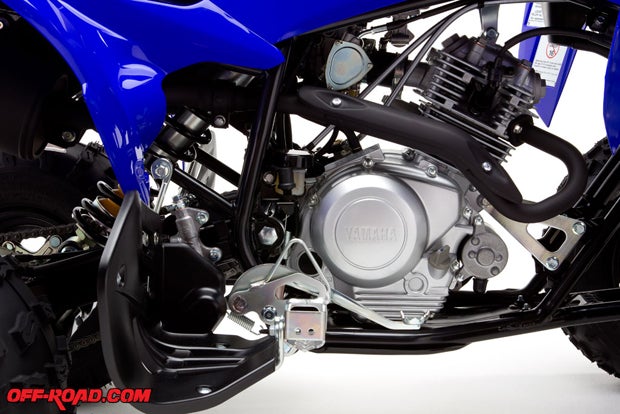
Thanks to its electric start, all it takes to bring the little Raptor to life is a simple push of a button in any gear. As we took the Raptor 125 a few laps around the track we were quick to notice the power it harnesses. The lightweight, five-speed, 124cc four-stroke engine produces a broad powerband that you can feel throughout the track. Of course, it doesn’t have as much power as the 250, but the 125 will get you around the track faster than you’d think. Surprisingly, the Raptor 125 had no problem lugging around the extra weight of even some of the heaviest riders in attendance.
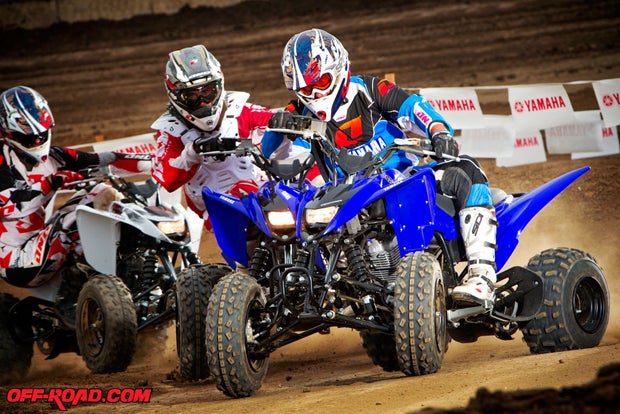
Yamaha sourced the engine for the Raptor 125 from its TTR125 dirt bike, but some modifications where made to make it better suited for ATV riding. The Raptor 125 has a different exhaust system, carburetor and cams to better suit the load of the ATV. The 125 shares the same three-chamber muffler design as the 250, which is light, quiet, and improves low- and mid-range performance. Vibration is kept to a minimum thanks to a single-axis counter balancer.
When we wanted to bring the 125 to a stop we were very impressed with its breaking capabilities for such a little ATV. The Raptor 125 features triple hydraulic disc brakes that work excellent – even in wet conditions!
The handlebar, seat, and footpeg ergonomics are designed specifically for smaller riders 16 years and older, but some of the editors in attendance were well over six-feet tall and said they were comfortable on the 125.
The Raptor 125 is not only comfortable, but it is one of the lightest ATVs in production. It weighs 30 lbs. less than the Raptor 250, making for an excellent power-to-weight ratio and exceptional acceleration and handling.
Almost immediately after taking the Raptor 125 out on the track, we noticed how easy it was to control and how well it handled over different obstacles. Steering effort is very light and with little effort you can kick the back end loose around corners, giving that feeling of riding a bigger bike. Even in the air the Raptor 125 is easy to correct and control.
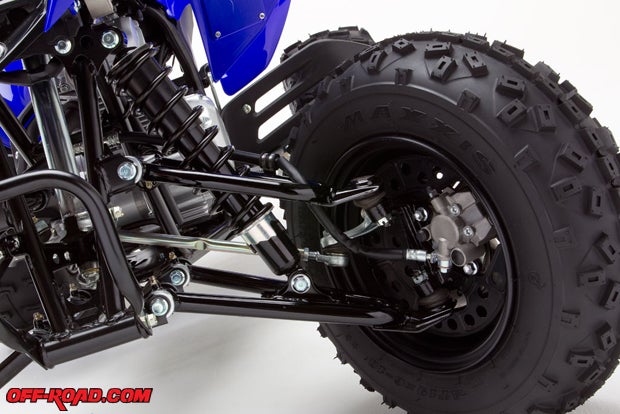
While riding we never experienced any bottoming out of the shocks. The Raptor 125 features the same proven shocks and A-arms as the Raptor 250. The front five-way adjustable shocks boast 7.5" of front wheel travel, giving the rider a very plush ride. It’s more suspension than this engine really needs and we’ve got no complains about that. Yamaha wanted the 125 to be well suited for riders of just about any weight. We found the shocks do a very nice job of soaking up bumps, whoops, and other obstacles throughout the track.
Connecting the Raptor 125 to the ground is a set of new low-profile Maxxis tires. Measuring 19 x 6-10 in the front and 18 x 9-8 in the rear, these tire sizes were chosen to help improve cornering and to provide excellent traction. Overall we found the tires hooked up quite well and we were still able to easily break the rear end loose when we wanted to.
One thing we would like to see in the future is the option to choose piggyback reservoirs on the shocks like the new 2011 Raptor 250. We feel that having that option would take the littlest Raptor to the next level. It would also be an advantage to those interested in getting into racing. Classes are already in place for motocross and cross country racing, and the Raptor 125 seems like it would be a natural fit for the young racer.
With its five-speed transmission, peppy engine, easy handling, and factory backed warranty the Raptor 125 is a force to be reckoned with in its class. We feel this alone will help make this transition from a 90cc ATV to a sport 250cc like the Raptor 250 much easier. Once new riders master the clutch and power of this Raptor 125 they will have a chance to excel in the sport and move up to bigger models. Since Yamaha now has class-leading machines in every class, the goal is for these new riders to show brand loyalty and stay with Yamaha in the long term – from the Raptor 90 youth quad all the way up to the YFZ450R or Raptor 700R. This seems like a sound strategy to us and one we expect other manufacturers to follow in the near future.
Get the Flash Player to see this player.


 Your Privacy Choices
Your Privacy Choices